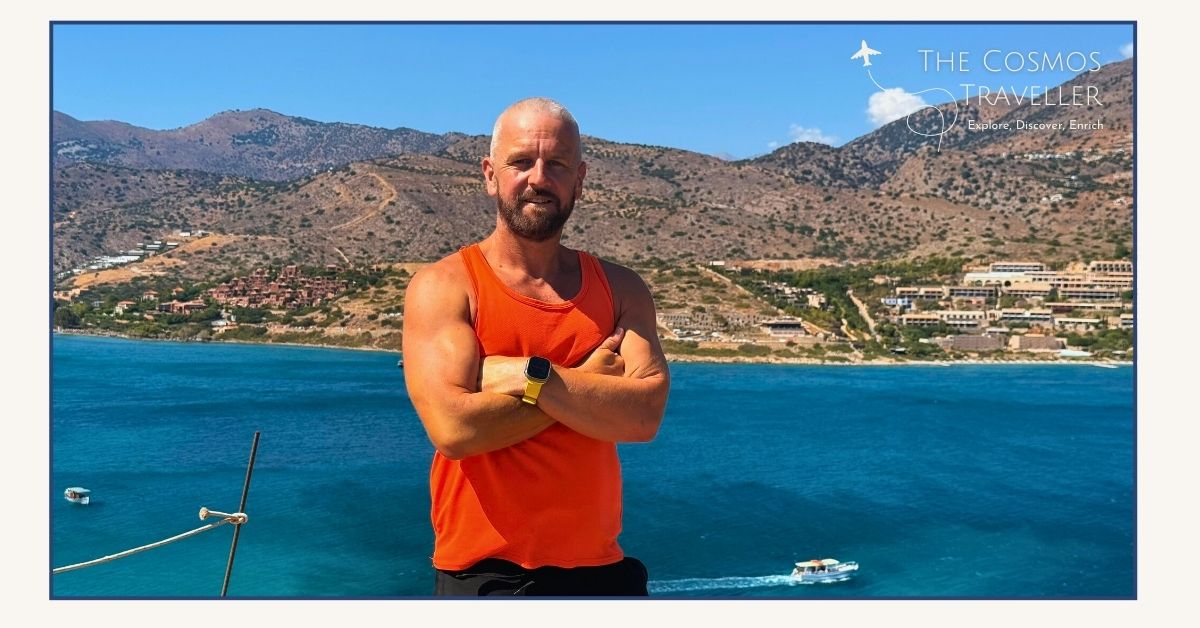How To Visit Spinalonga Island in 2025

I first visited Spinalonga Island in 1982, long before it became one of Crete’s most visited historic sites. Back then, there were hardly any tourists — just the sea breeze, the rustling of olive trees, and the towering presence of the Venetian fortress as we approached by boat. I was only six years old, but the memory of that journey, the island’s eerie quiet, and the crumbling leper colony has stayed with me ever since.
Fast forward to 2024 and 2025, I returned with my camera and curiosity sharpened, this time to document the island’s story and help others experience it fully. Whether you’re a history lover, a fan of Victoria Hislop’s novel The Island, or simply exploring the best things to do in Crete, visiting Spinalonga Island is an unforgettable experience.
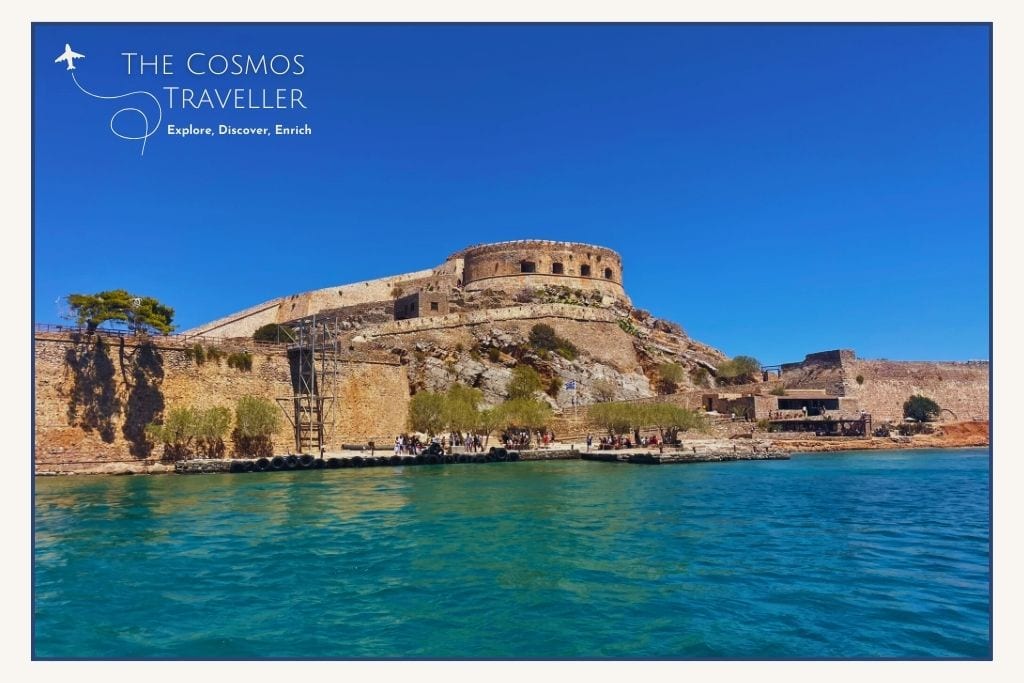
In this practical travel guide, you’ll find everything you need to plan your trip: from how to get to Spinalonga, boat tips from Plaka, tour recommendations, and insights on what to see, to Spinalonga travel tips for 2025 and beyond. I’ve also included personal reflections from my visits, plus up-to-date info gathered on the ground.
Quick Facts – How to Visit Spinalonga Island
📍 Location: Off the northeast coast of Crete, opposite Plaka (close to Elounda)
⛴️ Access: Shortest boat ride from Plaka (10 mins), also boats from Elounda & Agios Nikolaos
🎟️ Entrance Fee: €20 (April – October), €4 (November – March) – EU Citizens above 65 pay €10 (High season) €2 (Low Season)
⏰ Opening Hours: 08:30 – 18:00
⏱️ Time Needed: 1.5-2 hours on the island
📸 Must See Sights: Venetian Fortress, leper colony ruins, St George’s Church
📖 Literary Link: Setting for The Island by Victoria Hislop
💡 Top Tip: Go first thing in the morning or later afternoon to avoid the cruise/tour bus crowds
Where is Spinalonga Island, Crete?
Spinalonga Island is located in the Lasithi region of eastern Crete, nestled between the Bay of Mirabello and the lagoon of Elounda. Though small in size, its historical significance is vast.
The closest access point is the charming fishing village of Plaka, directly opposite the island, and arguably the best place to catch a boat for the fastest crossing. Just 5km south is the upscale resort town of Elounda, whilst the vibrant port city of Agios Nikolaos lies a little further along the coast.
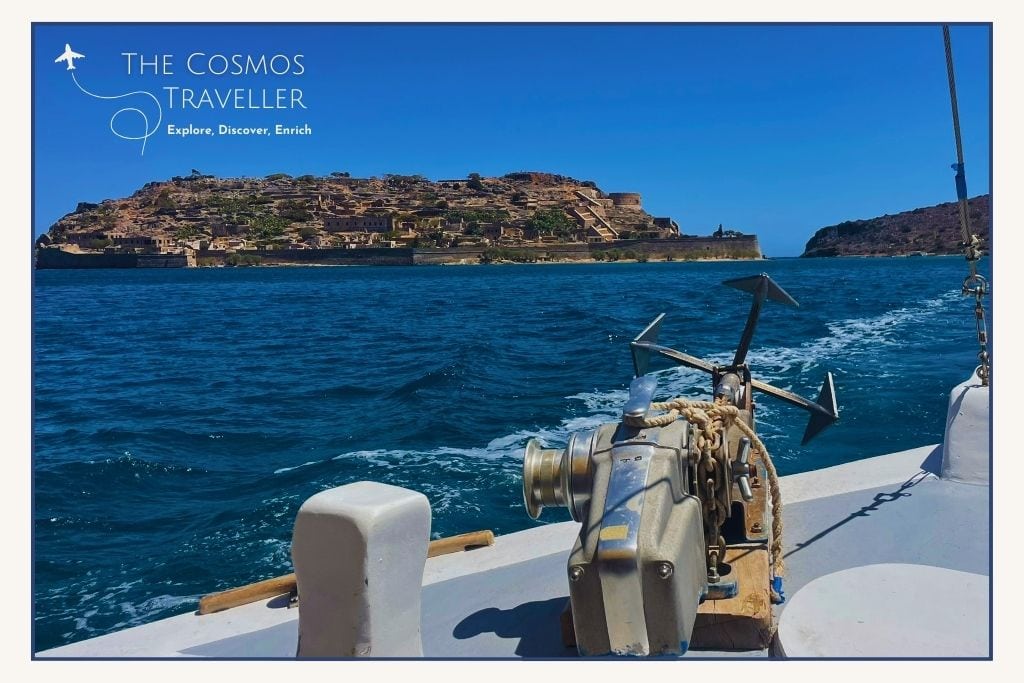
Today, Spinalonga is one of Crete’s most visited archaeological sites. Its haunting past as a Venetian fortress and later a leper colony makes it both beautiful and poignant. A story which has been immortalised by Victoria Hislop’s bestselling novel ‘The Island’.
In 2024, the site has been added to UNESCO’s Tentative List for World Heritage status, underscoring its cultural and historical value.
Map & Orientation
📍Below you will find an interactive map showing all the main highlights.
⭐ Tip: Click the star icon on the map title bar (“How to Visit Spinalonga Island in 2025″) to save this map to your Google account for easy access later.
How To Get To Spinalonga Island in 2025
You can visit Spinalonga Island via short boat trips from three towns: Plaka, Elounda, and Agios Nikolaos. Each offers different types of experiences – from quick DIY crossings to full-day guided tours.
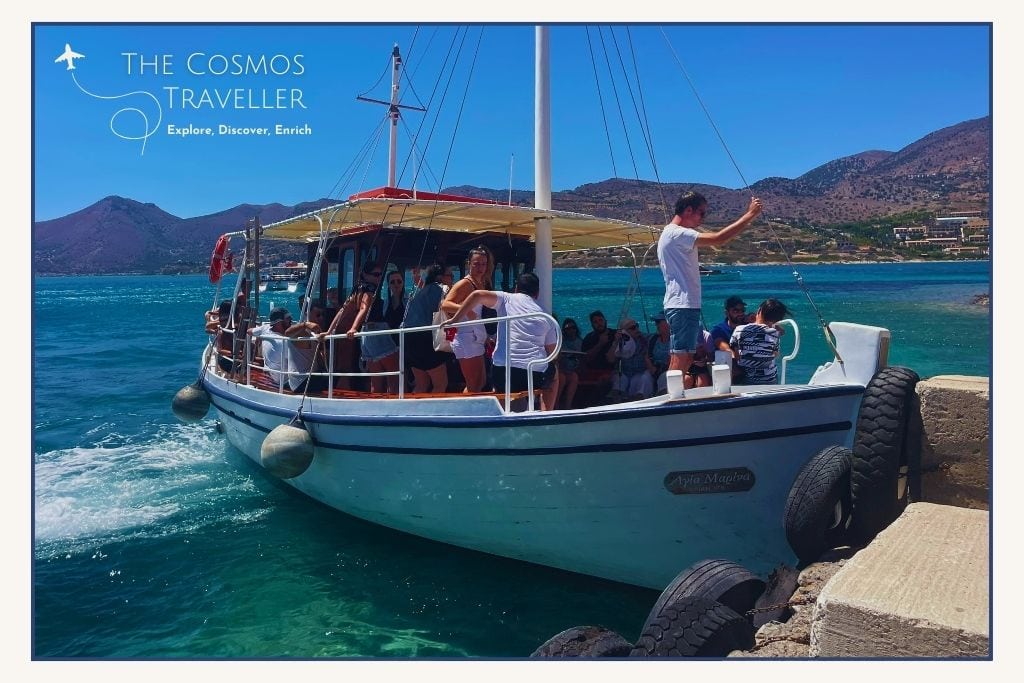
🚤 Spinalonga Boat Trip from Plaka (My Top Pick)
The smoothest, fastest and most scenic crossing to Spinalonga is from the tiny village of Plaka, just across the water. Boats run every 30 minutes, and the journey takes around 10 minutes.
- ⏱️ Crossing time: ~10 minutes
- 💶 Ticket price: €12 return (in 2025)
- 🎟️ No need to book ahead — just arrive and pay at the kiosk or jetty
- 👀 Best views of the Venetian fortress as you approach
💡Top Tip: I recommend this route for its ease, frequency, and the chance to stroll around Plaka’s seaside tavernas before or after your visit.
⛴️ Boat Trips from Elounda to Spinalonga
Elounda is a glamorous resort town about 5km south of Plaka. Boats to Spinalonga depart regularly from its small harbour and take around 20–25 minutes.
- ⏱️ Crossing time: 20–25 minutes
- 💶 Ticket price: ~€14 return
- 🧭 Often includes a short cruise around Kolokytha island
🌊 Spinalonga Day Trips from Agios Nikolaos
Boats also depart from Agios Nikolaos, but the journey is much longer — and more weather-dependent, especially on windy days when the Bay of Mirabello can be choppy.
While these trips are often sold as full-day excursions with onboard lunch or swimming stops, they’re less convenient for travellers wanting to explore the island in depth.
- ⏱️ Crossing time: 1.5 hours
- 💶 Price: Varies (€30–50+ with tour inclusions)
- 🌊 Note: More exposed to wind and waves in the Bay of Mirabello
💡 My tip: For a smoother, more flexible visit, take a taxi or bus to Plaka and cross from there. Not only is it the shortest route, but you’ll also get time to explore this beautiful fishing village – the real-life setting of ‘The Island’ by Victoria Hislop.
🔍 Visiting Spinalonga with a Tour
There are plenty of big-group tours available from Agios Nikolaos and Elounda – but if you’re like me, you might prefer to explore Spinalonga at your own pace.
That’s why I suggest arriving early (before the crowds), using the self-guided route I’ve outlined below and giving yourself time to absorb the island’s layered history. It’s a much more meaningful experience than being herded past the highlights.
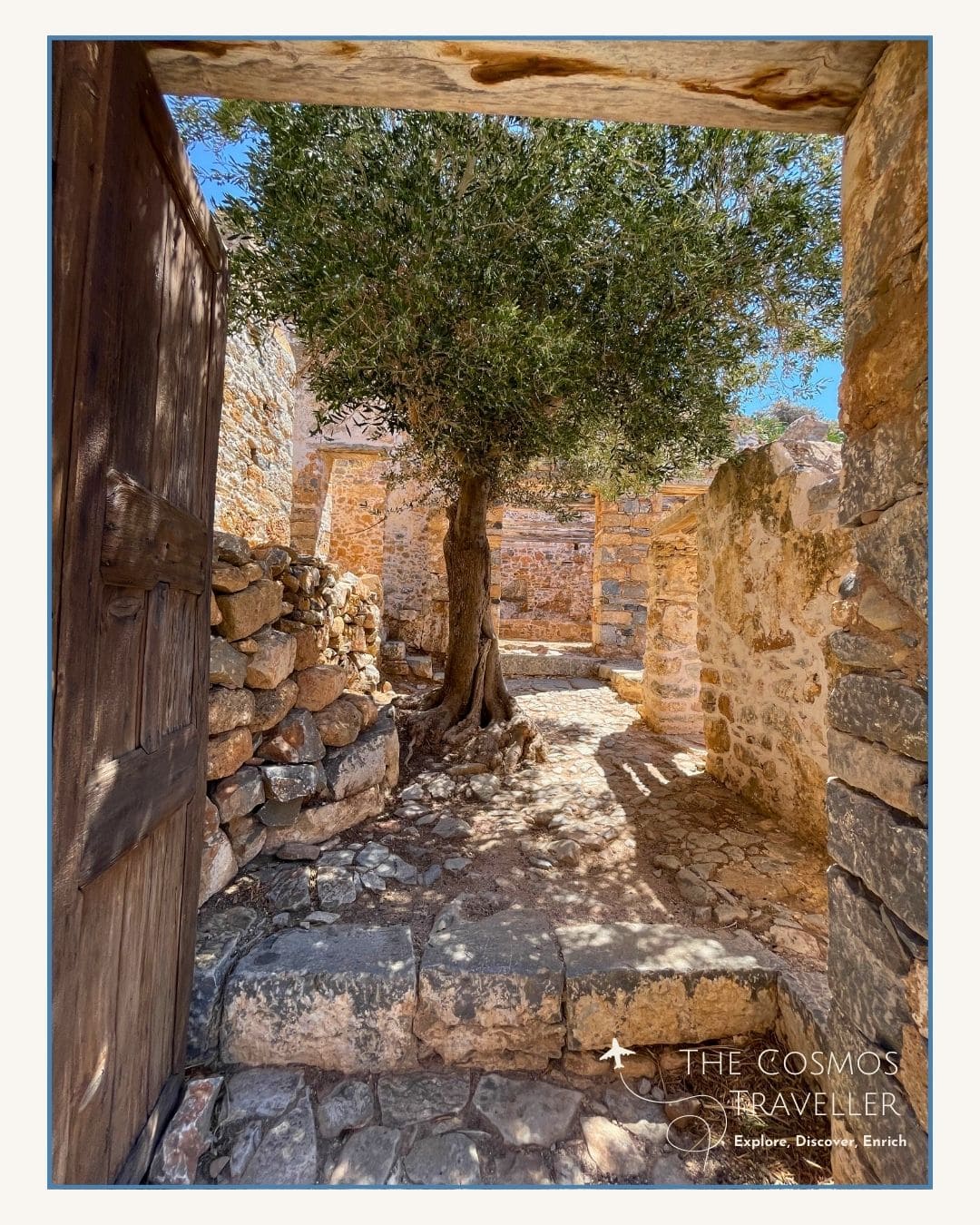
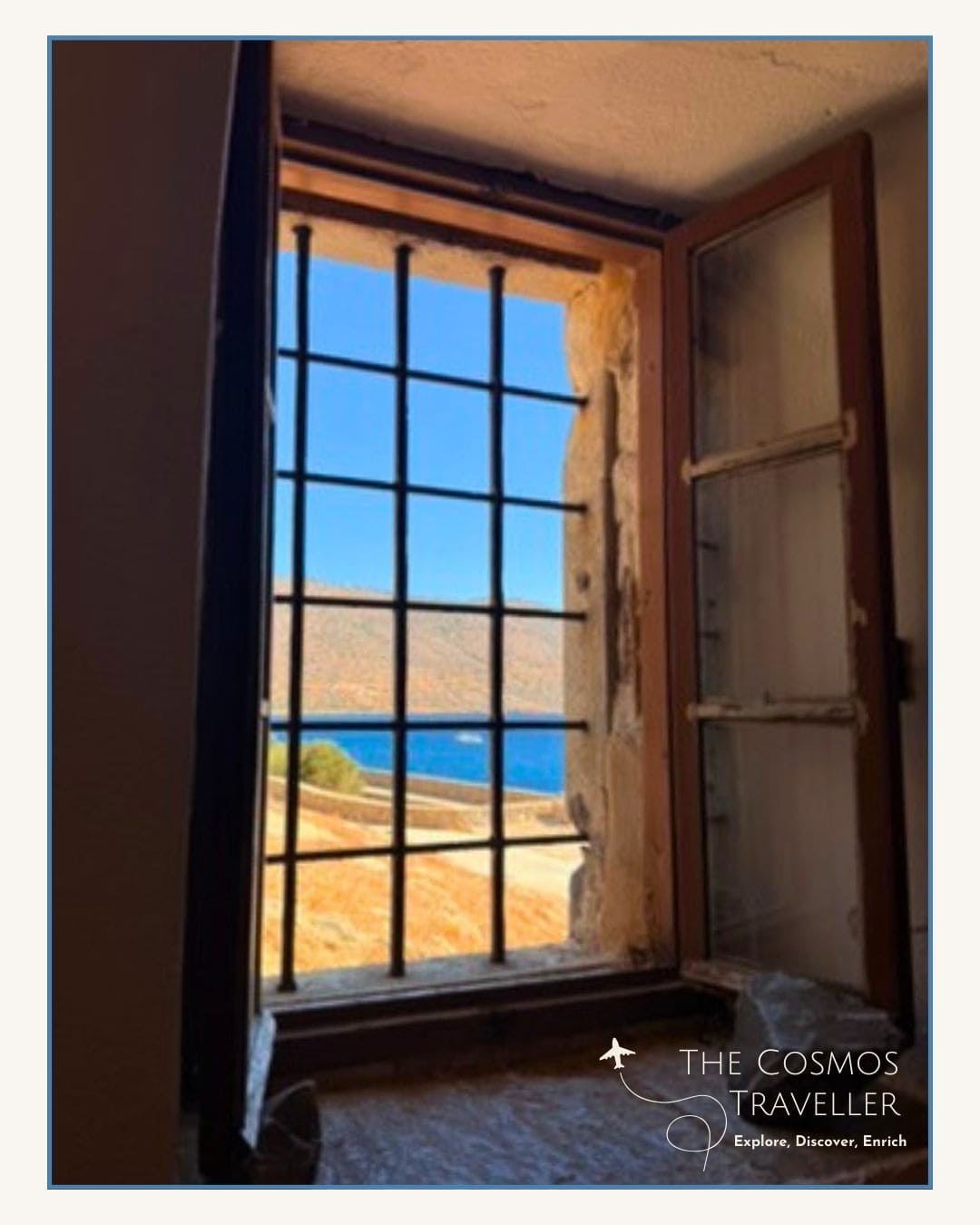
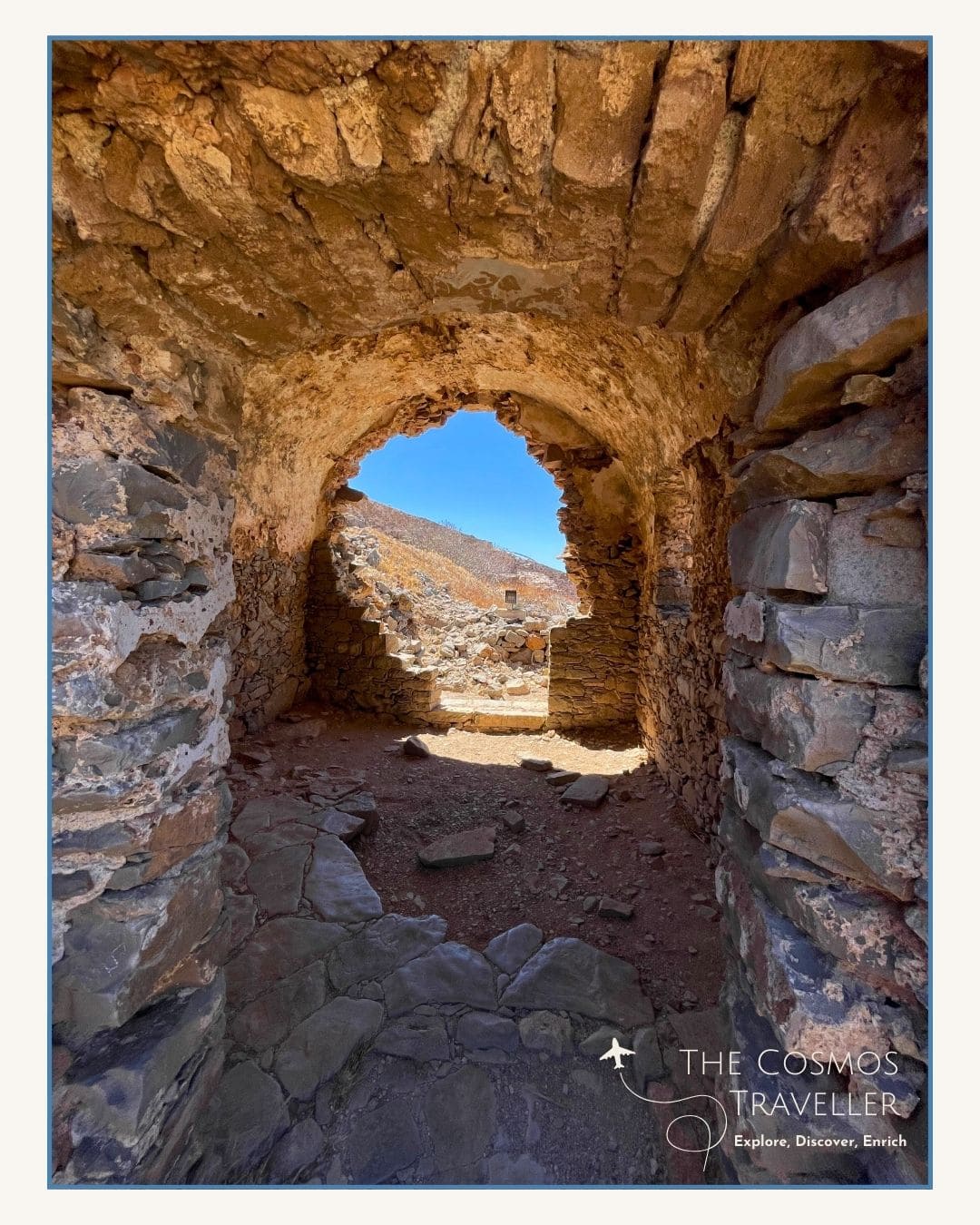
👉🏽 Prefer a guided experience?
I haven’t found a small-group tour I’d genuinely recommend just yet – but I’m always looking. If you’d like me to let you know when I do, please click here to drop me an email – I would love to hear from you!
💡 Top Tip: Save or print this guide before you go — it covers all the key landmarks, plus the backstory many visitors miss.
Spinalonga Opening Hours, Tickets & Accessibility
Before you set off, here’s everything you need to know about visiting Spinalonga Island in 2025 — including entry fees, seasonal opening times, public holidays, and mobility access.
🎟️ Spinalonga Ticket Prices
|
Season |
Full Price |
Reduced Price |
|---|---|---|
|
April 1 – October 31 |
€20 |
€10 |
|
November 1 – March 31 |
€4 |
€2 |
Who qualifies for a reduced ticket?
Citizens of European Union member states over the age of 65 (with valid ID), visiting between October 1st and May 31st.
You can purchase tickets on-site or via official tour operators. Entry is included in some guided tours from Plaka, Elounda, or Agios Nikolaos (see options above).
👉🏼 Click here for the official government site of Spinalonga Island outlining all the opening times and entry prices.
🆓 Free Admission Days
Entry to Spinalonga is free on the following days:
- March 6 – In memory of Melina Mercouri
- April 18 – International Day for Monuments
- May 18 – International Museum Day
- Last weekend of September – European Heritage Days
- October 28 – Oxi Day
- Every first Sunday of the month from November 1 to March 31
⚠️ Tip: These are popular days — arrive early to avoid long queues at the port and on the island.
🕒 Opening Hours
- April 1 – October 31: Open daily from 08:30 to 18:00
- November 1 – March 31: Closed to the public except by group request
- Last entry is usually 30 minutes before closing time
Visiting hours may change due to weather or ferry schedules — always check locally if high winds are forecast.
📆 Public Holidays
Spinalonga is closed on:
- January 1
- March 25
- May 1
- Easter Sunday
- December 25–26
It is open with reduced hours or by appointment on:
- Epiphany, Ash Monday, Good Friday, Easter Monday, Holy Spirit Day, August 15, October 28
♿ Accessibility
Spinalonga is not fully wheelchair-accessible due to uneven terrain and historic ruins, but a flat path runs along the island’s main perimeter. This makes it possible for elderly visitors or those with limited mobility to experience the island without hiking uphill.
💡 Tour Tip: If you or your companions have mobility concerns, choose a shorter visit departing from Plaka, where the boat ride is smoother and faster.
A Brief History of Spinalonga Island
From ancient fortifications to its haunting role as Greece’s last leper colony, Spinalonga’s history is layered, complex, and unforgettable. Here’s a short timeline to bring it to life:
🕊️ Byzantine Era (7th–12th century)
Though little is known about Spinalonga’s early history, archaeological finds reveal Byzantine-era walls likely built to defend against Arab raids. The island guarded the Gulf of Elounda, serving as part of a larger coastal defence network.
🛡️ Venetian Fortress (1579–1715)
The Venetians fortified Spinalonga in the late 16th century as part of Crete’s strategic defenses against the Ottomans and pirates. It became one of the most important military harbours after Souda, with bastion-style walls still visible today.
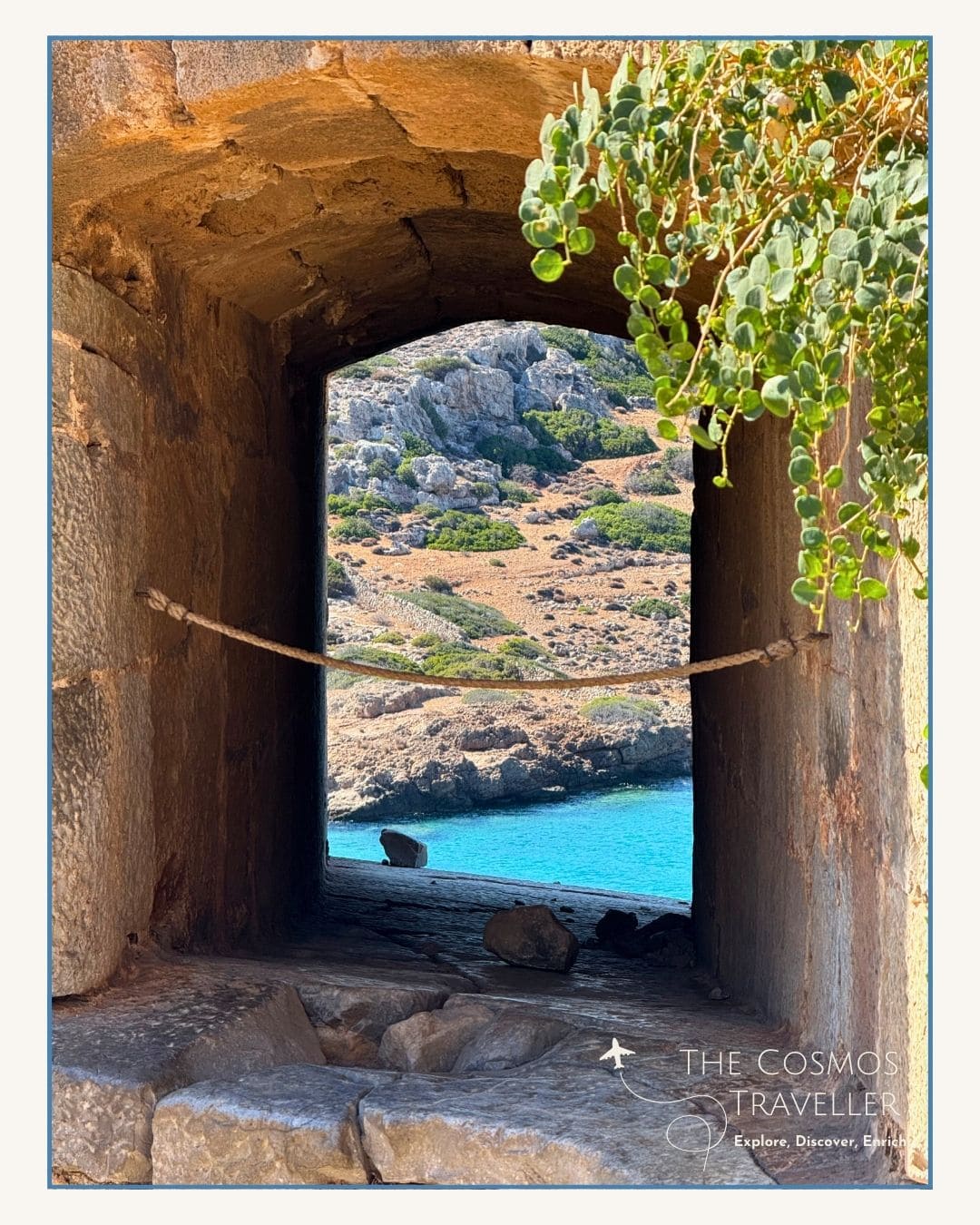
🕌 Ottoman Occupation (1715–1903)
After a brutal siege, the Ottomans took control of Spinalonga and used it as a trading port, prison, and military base. A multicultural community developed, though it also became a site for exile, imprisonment, and the slave trade.
⛑️ Leper Colony (1903–1957)
In the 20th century, Spinalonga became Greece’s official leper colony. People with Hansen’s disease were forcibly isolated here, many living in squalid conditions, cut off from the world. Over time, residents created a self-governed community, building roads, libraries, and support systems. Treatments arrived in the 1940s, and the colony closed in 1957—but the stories of those years still echo through the ruins.
🌅 Modern Tourism & Restoration (Post-1957)
Spinalonga was abandoned for decades before restoration works began. Today, it’s one of Crete’s most visited sites, drawing interest for its Venetian fortress, tragic leprosy past, and cinematic beauty. In 2014, Greece submitted a nomination for UNESCO World Heritage status, and in 2024, Spinalonga was added to UNESCO’s tentative list.
What to See on Spinalonga Island
My tried-and-tested route for seeing the island differently.
Having first visited Spinalonga in 1982 — and returned again in 2024 and 2025 — I’ve learned that the best way to see the island isn’t the official clockwise route. If you want a more reflective, less rushed visit, try this instead:
1. Start at the Tunnel — and then turn right
As you arrive, go through the dark tunnel just as the lepers once did. It’s a sobering moment — stepping into a place that changed lives.
But don’t follow the group straight ahead. Instead, take an immediate right and head uphill toward the Venetian fortress.
2. Explore the Venetian Fortress
At the top, you’ll find bastions, panoramic views, and the oldest part of Spinalonga — where Crete’s Venetian past still echoes in the stones. It’s usually quiet here early in the day.
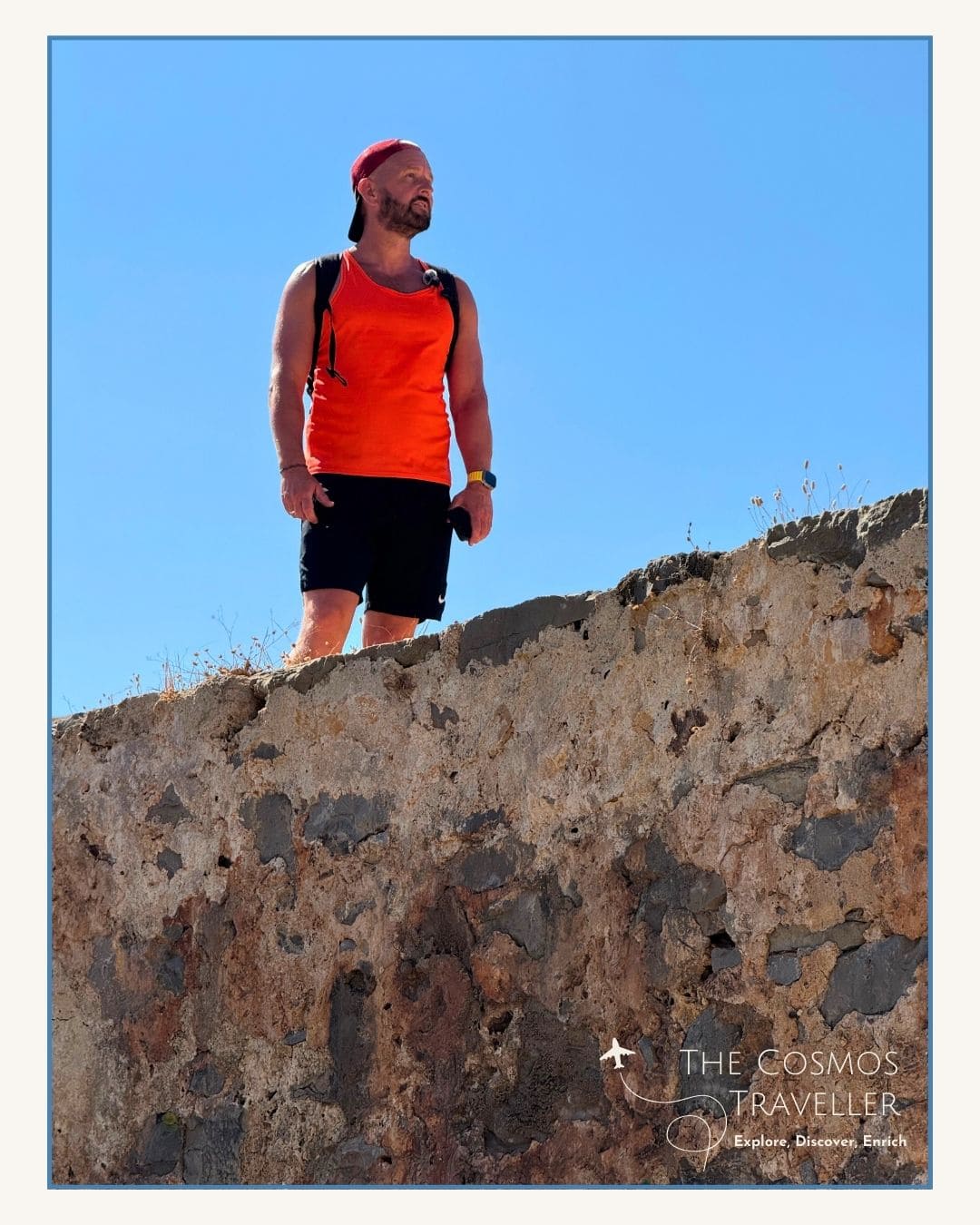
3. Visit the Graveyard
Come back down from the fortress and keep left to come back to the main path, reaching the cemetery, which was once a bastion of the island. It’s simple, moving, and strangely peaceful — a place to pause and reflect and remember the many lepers that lost their fight against the disease in exile here.
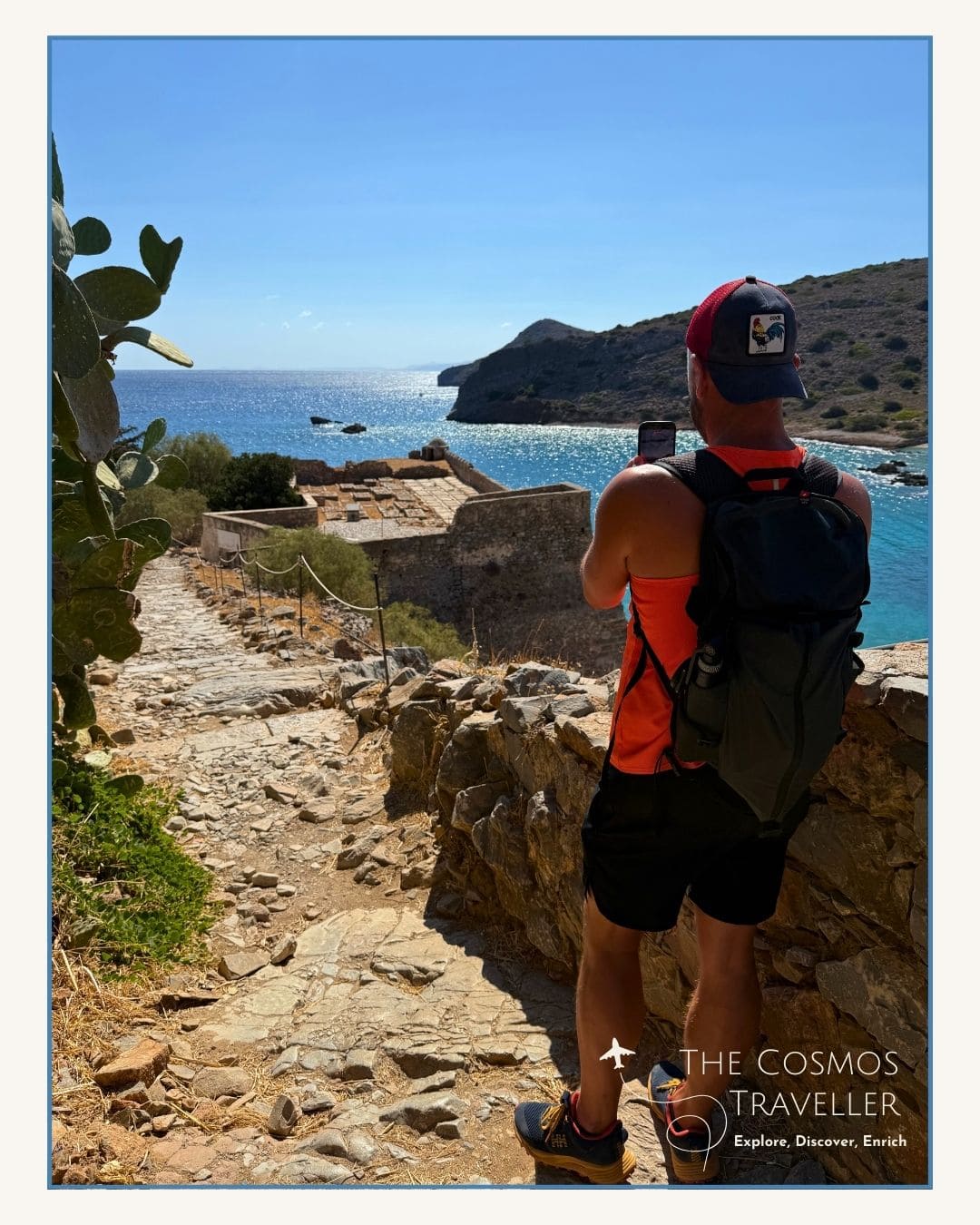
4. Circle past the Church of St George
From the cemetery, continue along the quieter north-facing perimeter. The sea feels closer here. The Church of St George, small and humble, marks one of the final chapters of the island’s story. Inside, if you are lucky enough to find it open (as I did in 2025) you can see two beautiful paintings of Christ, painted by 2 different lepers from the island community.
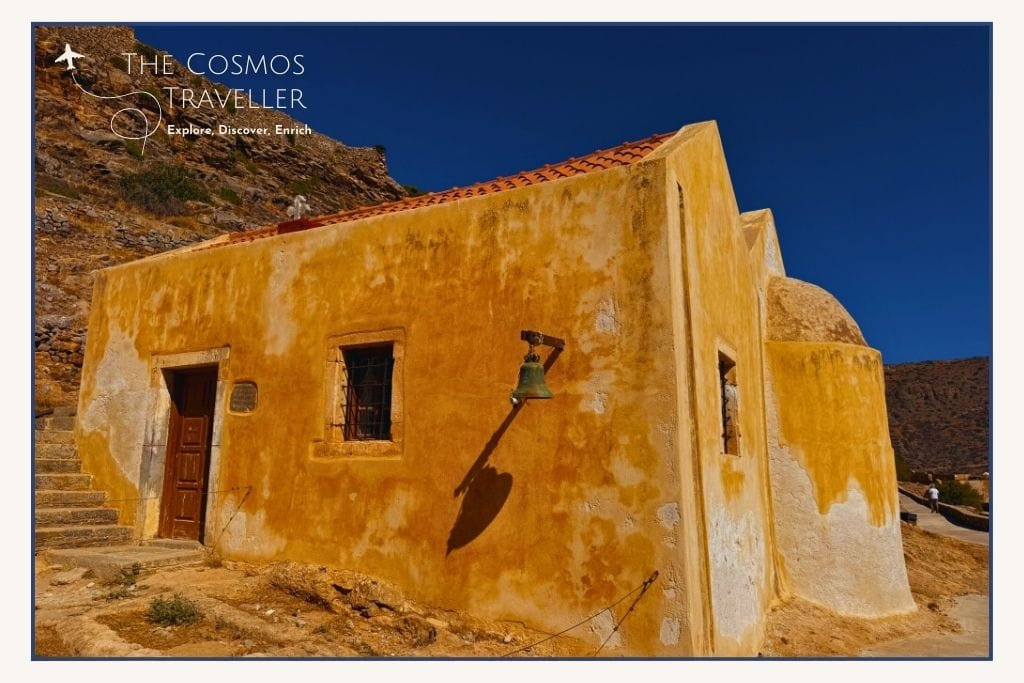
5. Climb to the Summit
As you loop around the back of the island, look for a path leading behind the old buildings — it takes you up to the highest point of Spinalonga. Few people come here. From the summit, the view stretches all the way back to Plaka and the mainland. Make the effort to walk the entire summit ridge from north to south – it’s unforgettable.
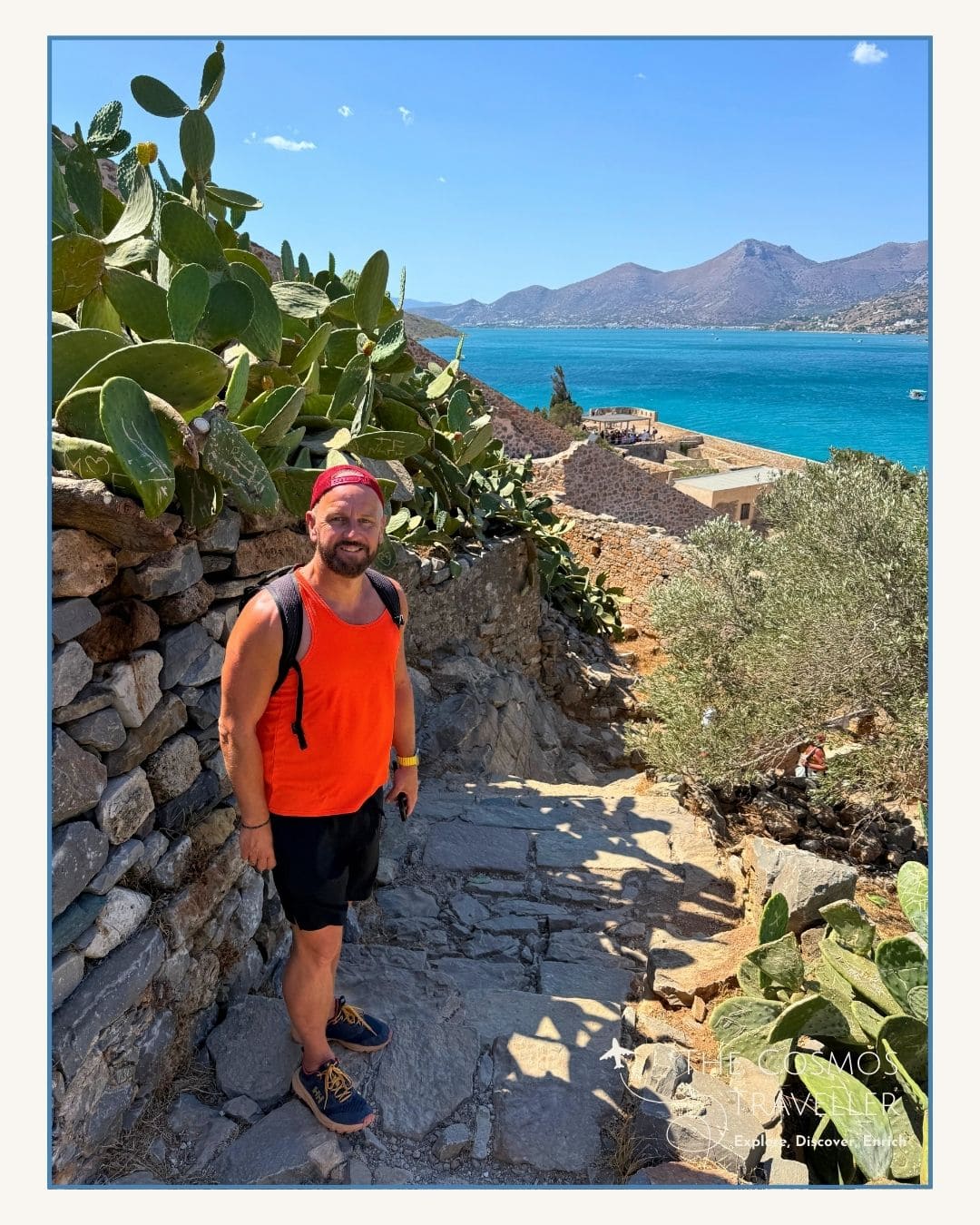
📸 Viewpoint Tip: at the north part of the summit there is a beautiful old doorway, just made for the perfect instagram shot!
6. Descend through the Village Ruins
Weave your way back down through broken homes and alleyways. This descent feels like time folding back in on itself — stones, plants, and stories overlapping as you rejoin the Ottoman village.
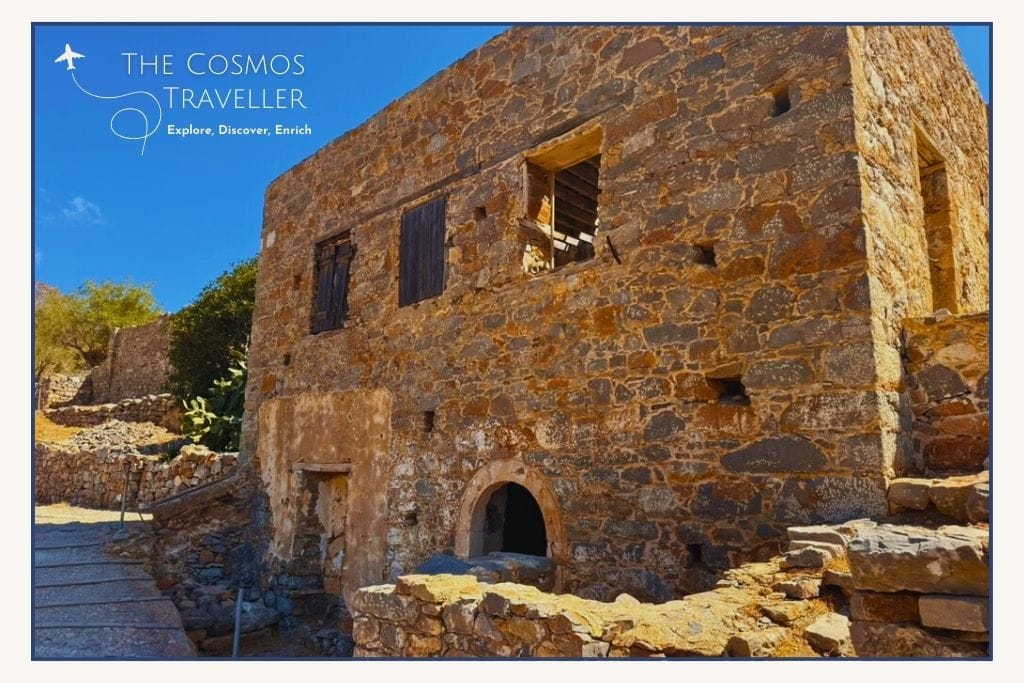
🏛️ End with the “Main Sites”
Now it’s time to see what most visitors do — but with more context.
Walk through the restored Ottoman street, making sure to take in the following sights;
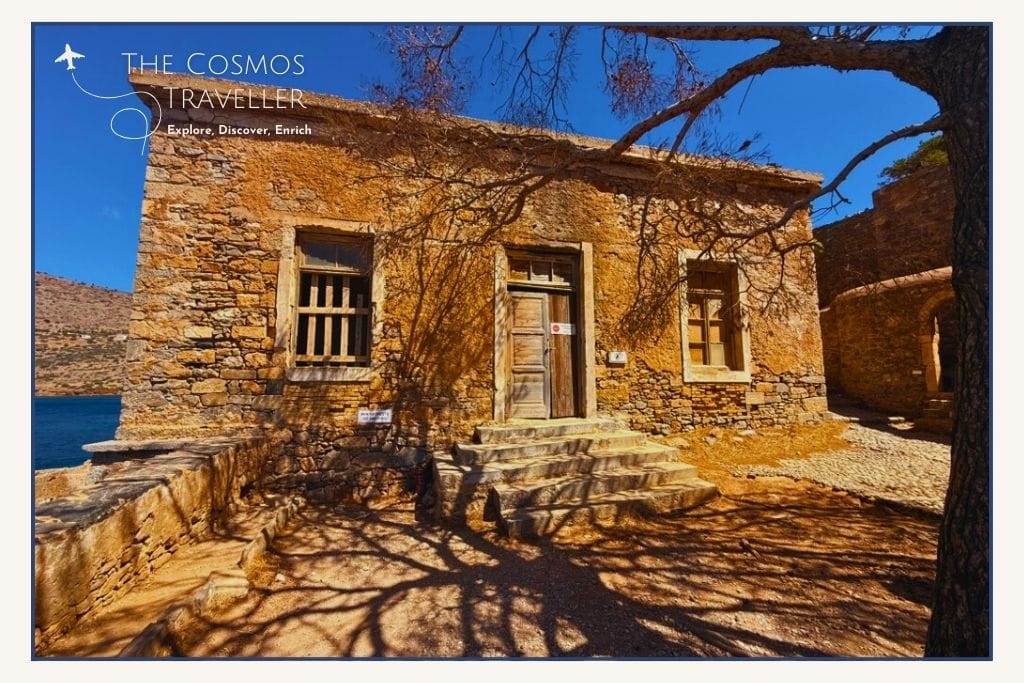
- The leper hospital which was once an Ottoman Mosque
- The dormitories – The dormitories were built between 1937 and 1939 to improve patient conditions. Their mix of stone and concrete makes them look centuries old — but they’re not.
- The disinfection chamber – once the garrison building of the Venitians (constructed in 1579) was used to disinfect objects such as money and letters being transferred outside of the island.
- The main gate or Porta Maestra is impressive in its Tuscan architectural style. It was the official entrance to Spinalonga during the Venetian, Ottoman and Leper colony eras.
- The Agios Panteleimon church — which was renovated in 1953, with donations from the patients living on the island. Saint Panteleimon was the patron saint of people suffering from leprosy.
- The homes – for me the highlight is exploring these houses, once inhabited by the lepers themselves, trying to live as normal as possible life as possible. Built during the Ottoman period, the buildings were allocated to new patients as they arrived on the island.
💡 Top Tip: Save this walking route for your own visit – and if you take the summit shot, tag me on Instagram @thecosmostraveller so I can see it!
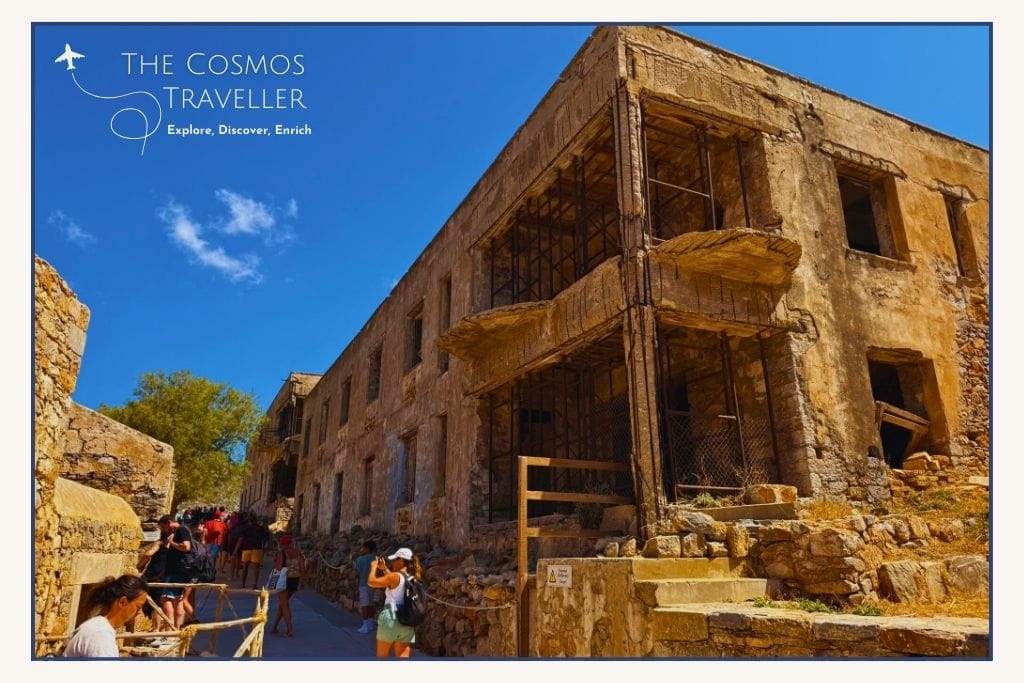
The Victoria Hislop Spinalonga Connection
If you’ve read The Island or One August Night, you already know how deeply Victoria Hislop’s storytelling brings Spinalonga to life. Her writing doesn’t just describe the leper colony, it gives voice to the people who lived, loved, and suffered here. For many readers, The Island is the reason they come.
It certainly was for me in 2025.
I first visited Spinalonga as a child, long before Hislop’s book was published. But when I returned in 2024 and read The Island and One August Night back-to-back afterwards, I was completely captivated. Her characters filled in the silences of the ruins. Her descriptions made the dust, hardship, and hope feel vividly real. It was that emotional connection that brought me back again this year. We even made a huge detour from the south coast of Crete just to revisit the island.
And then something extraordinary happened.
📍 Meeting Victoria Hislop in Plaka
Just a few days ago, I saw Victoria being interviewed in Plaka, the tiny fishing village across the water from Spinalonga. When she finished, I walked over, introduced myself, and told her I’d visited in the 1980s – before the books, before the crowds and that I had to come back for a third time after reading her novels.
She smiled, genuinely curious, and we chatted for a while. It was one of those magical travel moments. Honest, human, unforgettable.
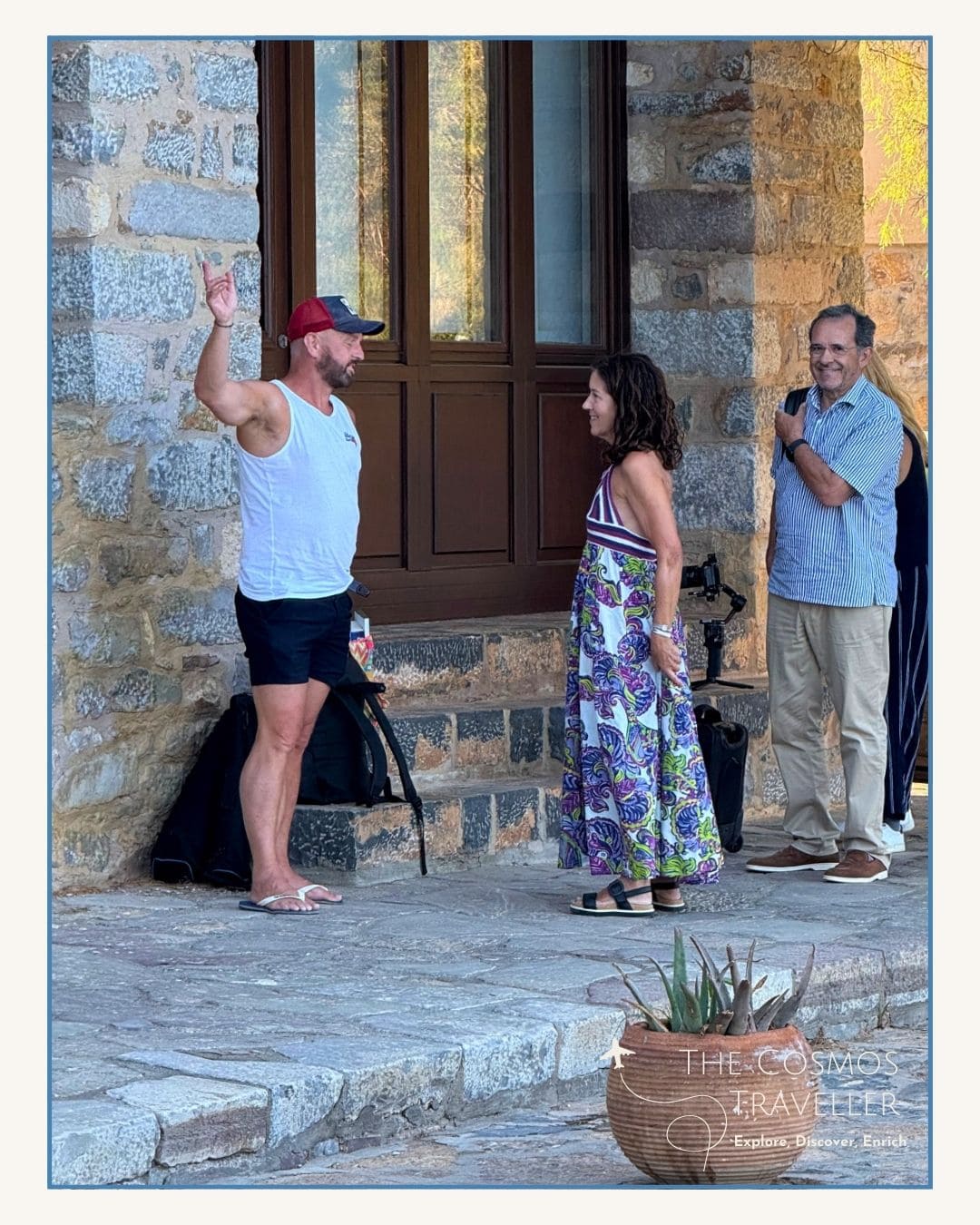
✨ What’s real vs. fictional?
Victoria Hislop’s novels are based on true events, but with fictional characters. The history is real:
- Spinalonga was a leper colony between 1903 and 1957.
- Patients lived, worked, and even fell in love on the island.
- Many structures – like the hospital, disinfecting chamber, and dormitories – still stand.
But the stories of Eleni, Giorgios, Maria, and Anna in The Island are fictional – woven together to help us understand the real emotional weight of exile, stigma, and resilience.
🧭 What to look out for as a fan
If you loved The Island, don’t miss:
- The tunnel: The emotional entry point for new arrivals — just as in the book.
- The village homes: Imagine the characters trying to build normal lives in these crumbling houses.
- The hospital: Still standing, and haunting.
- The cemetery: Small, quiet, and deeply moving — where the story’s final chapters echo most.
- Plaka: Hislop’s novels gave this village global fame. Sit by the water, order a Greek coffee, and imagine the scenes unfolding across the bay. In fact I stayed for 3 nights and was captivated by the little town.
My Tips for Visiting Spinalonga in 2025
With three visits under my belt, here are my tried-and-tested tips for making the most of your visit.
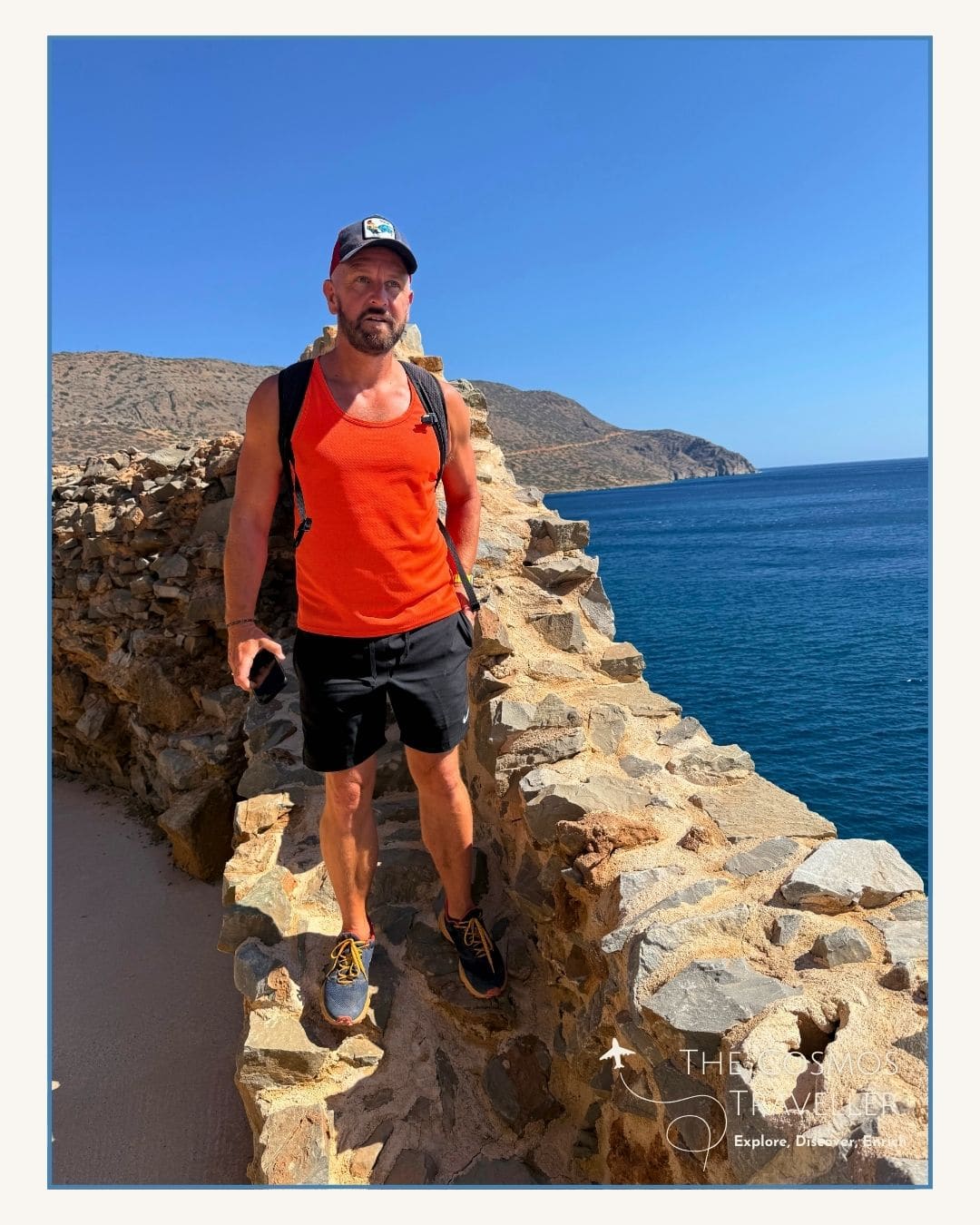
⏰ 1. Go Early — Before the Crowds
Take the first boat from Plaka at 10:00 AM. You’ll arrive before the large tour boats from Agios Nikolaos and Elounda, which means quieter paths, better photos, and a more reflective experience.
☀️ 2. Come Prepared: Sun, Water & Shoes
There’s little shade on the island and it gets hot.
Bring:
- 🧢 A sun hat
- 💦 Plenty of water
- 👟 Proper shoes — avoid flip-flops! I met a lovely French woman who wanted to climb to the summit but had to turn back because of her sandals.
🗺️ 3. Use My Self-Guided Route
You can visit independently, but I recommend saving this guide to help you uncover Spinalonga’s layers of history — and avoid missing powerful sites like the cemetery or summit.
Many visitors walk the main path without knowing the full story. A little background knowledge will make the experience far more meaningful.
📍 4. Use My Google Map for Photo Stops
Want to find the most scenic photo spots or lesser-known corners?
I’ve marked my favourite photo points — like the summit doorway and fortress view — on this custom Google Map.
Save it before your visit so you don’t miss the best shots.
👨👩👧 5. Is it Family-Friendly?
Yes — though younger kids may not grasp the emotional weight. I visited as a child and still remember it, but now as an adult, the island’s story feels even more profound.
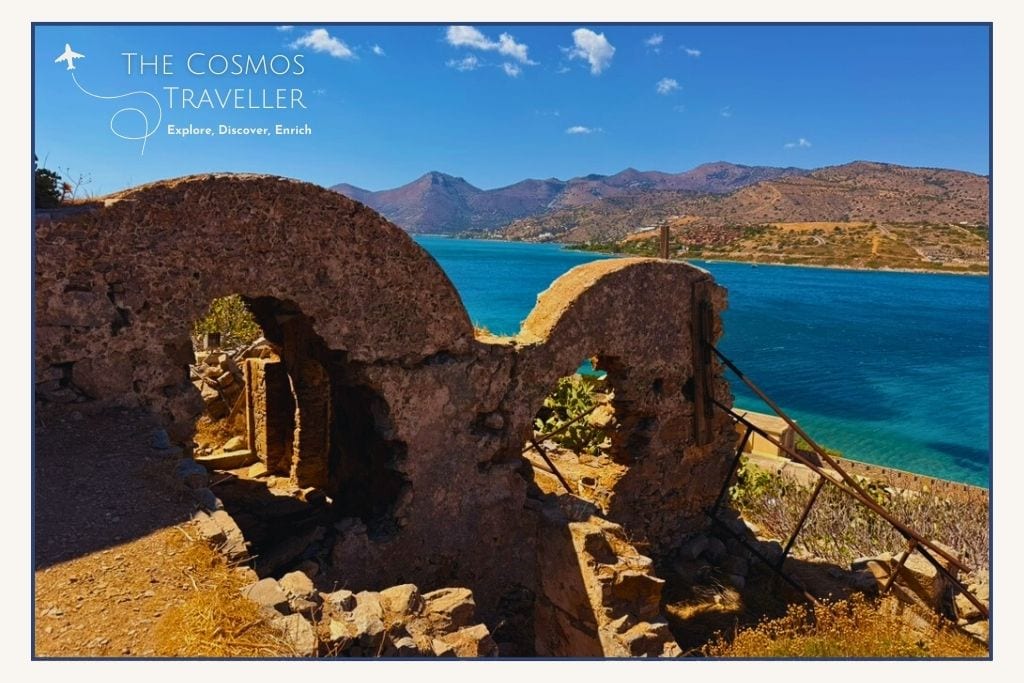
Where to Stay Nearby
Looking to base yourself close to Spinalonga? Here’s a quick overview of your options – from fishing village charm to full-service towns:
🛶 Plaka
Best for: Easy access to Spinalonga
This is where I stayed and where I recommend you stay if your main goal is to visit the island. It’s literally walking distance to the boat pier, and staying here means you can take the first boat of the day and avoid the tour crowds. A few great seafront tavernas and small boutique apartments give it a relaxed, local vibe.
→ The Petra Elounda Suites are the best place to stay in Plaka, in the heart of town and right on the water with uninterrupted views of Spinalonga.
🍽️ Elounda
Best for: More dining and resort-style options
If you’re looking for a bit more choice — larger hotels, sunset dinners, or even a spa break — Elounda is your spot. It’s about 10 minutes by car or taxi from Plaka, and there are boat tours to Spinalonga from here too.
→ Elounda Palm Hotel & Suites offers top quality, luxurious accommodation.
🏙️ Agios Nikolaos
Best for: A full-service Cretan town
Further afield (around 30 minutes), Agios Nikolaos is a vibrant harbour town with nightlife, shopping, and a bigger selection of hotels. Great if you’re combining your Spinalonga visit with a wider trip across East Crete.
→ Luxury Suites by Lato offer modern luxury in the heart of town.
💡 Local experience tip: If you’re planning a longer trip, I also loved staying inland near the mountain village of Monastiraki — peaceful, local, and less than 20 minutes to the coast.
→ Read more in: Where to Stay in Crete for a Local Experience 🔗
FAQs About Visiting Spinalonga
🗺️ Where is Spinalonga Island located?
Spinalonga sits off the northeastern coast of Crete, just across the water from the villages of Plaka and Elounda.
🚤 Can you visit Spinalonga without a tour?
Yes — boats leave regularly from Plaka, Elounda, and Agios Nikolaos. You can explore independently, or use my self-guided route to get the most out of your visit.
⏱️ How long does it take to visit Spinalonga?
Allow 1.5 to 2 hours to walk the island at a relaxed pace, including the summit. You can stretch this longer if you linger or picnic.
📆 Is Spinalonga worth visiting in 2025?
Absolutely. With its layered Venetian, Ottoman, and leper colony history — and the vivid storytelling from The Island by Victoria Hislop — it’s one of Crete’s most powerful places to visit.
My Final Thoughts – Is Visiting Spinalonga Island Worth It in 2025?
Spinalonga Island isn’t just a photo stop — it’s one of the most emotionally powerful places to visit in Crete.
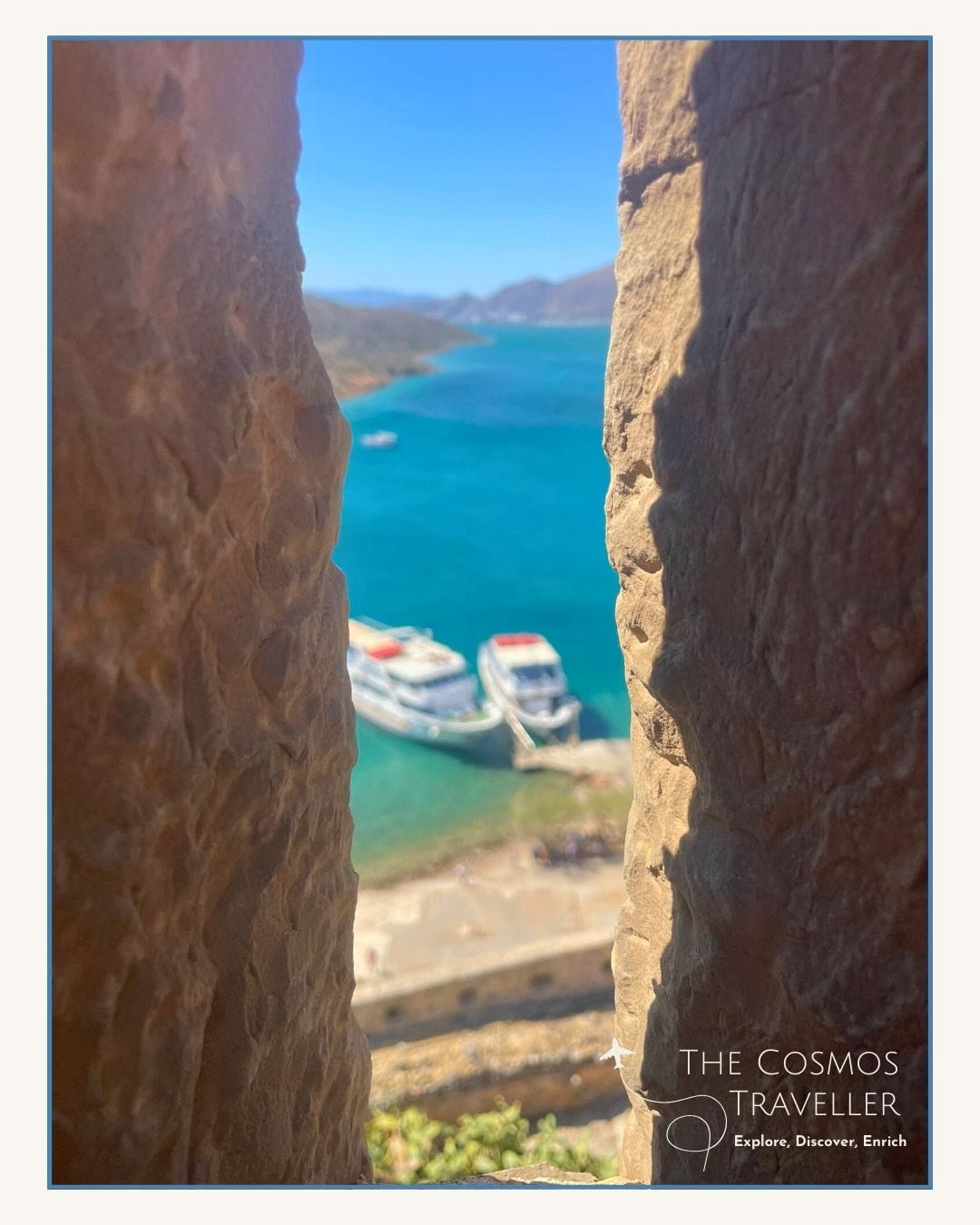
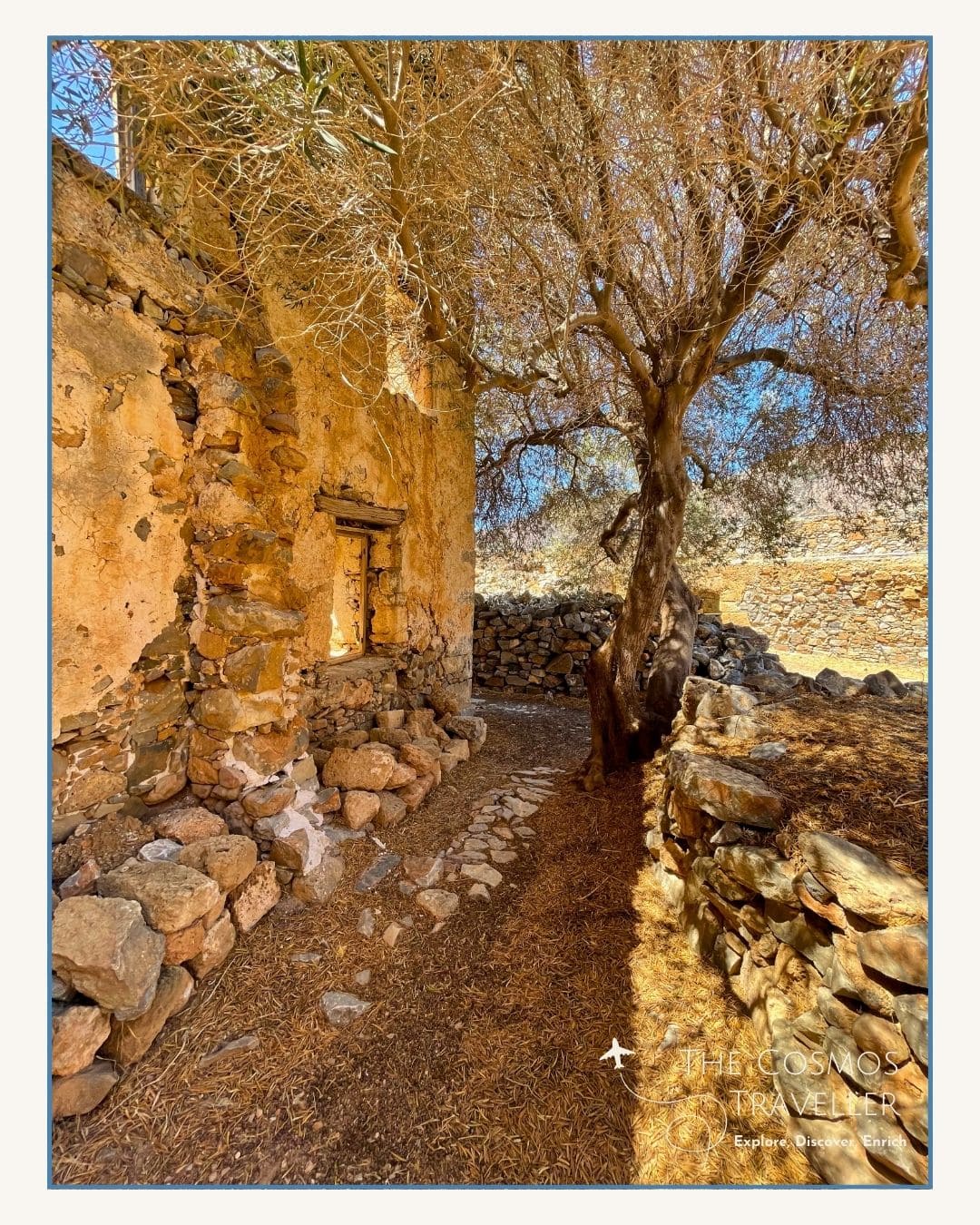
Yes, the views are stunning. Yes, the boat ride from Plaka is a highlight. But what stays with you is the layered history — from Venetian fort to Ottoman stronghold, to its time as a leper colony in the 20th century. That legacy, combined with stories like Victoria Hislop’s The Island, transforms Spinalonga into something unforgettable.
Returning decades later helped me see Spinalonga differently. I followed my own route, away from the crowds, and felt the significance of the past more deeply than ever before.
If you’re planning your own Spinalonga boat trip, I urge you to learn a little of its history before you go. You’ll experience it not just as a tourist destination, but as a living story of resilience, humanity, and remembrance.
I may not return in 2026, but I know I’ll be back again someday. Spinalonga Island Crete has that kind of hold on you.
👇🏼 Save this guide, share it with your travel companions, and don’t forget to pin, post, or message it to yourself for later.
If you loved my Spinalonga Guide, check out my Perfect One Week Itinerary for visiting Crete!

Written by Richard Hoskisson
Founder of The Cosmos Traveller
With over 30 years of travel experience across France, South Africa, the UAE and Greece – and many more far flung places – Richard helps curious travellers explore hidden gems, discover culturally-rich adventures and enrich their travel stories.
Published September 2025
